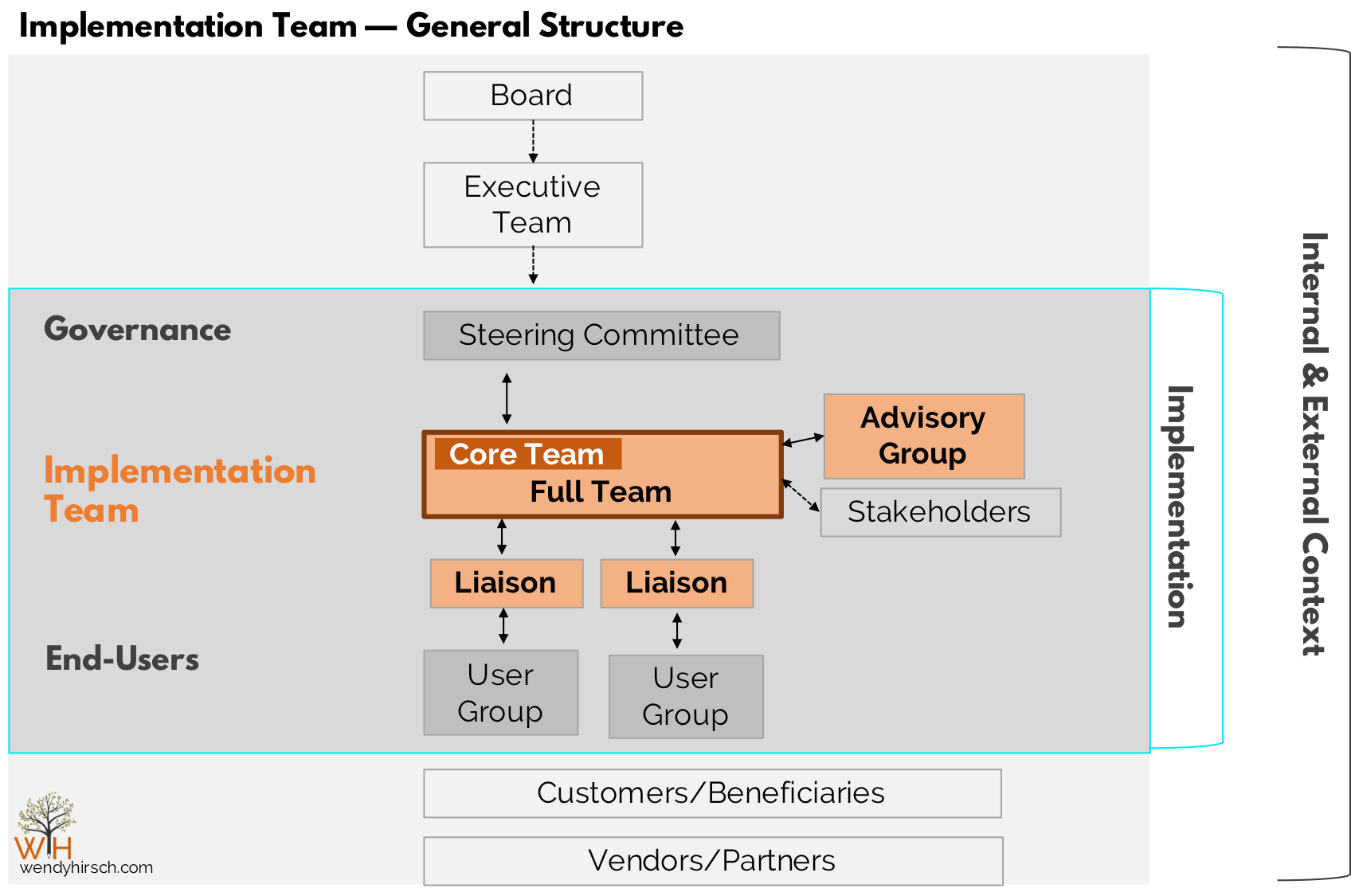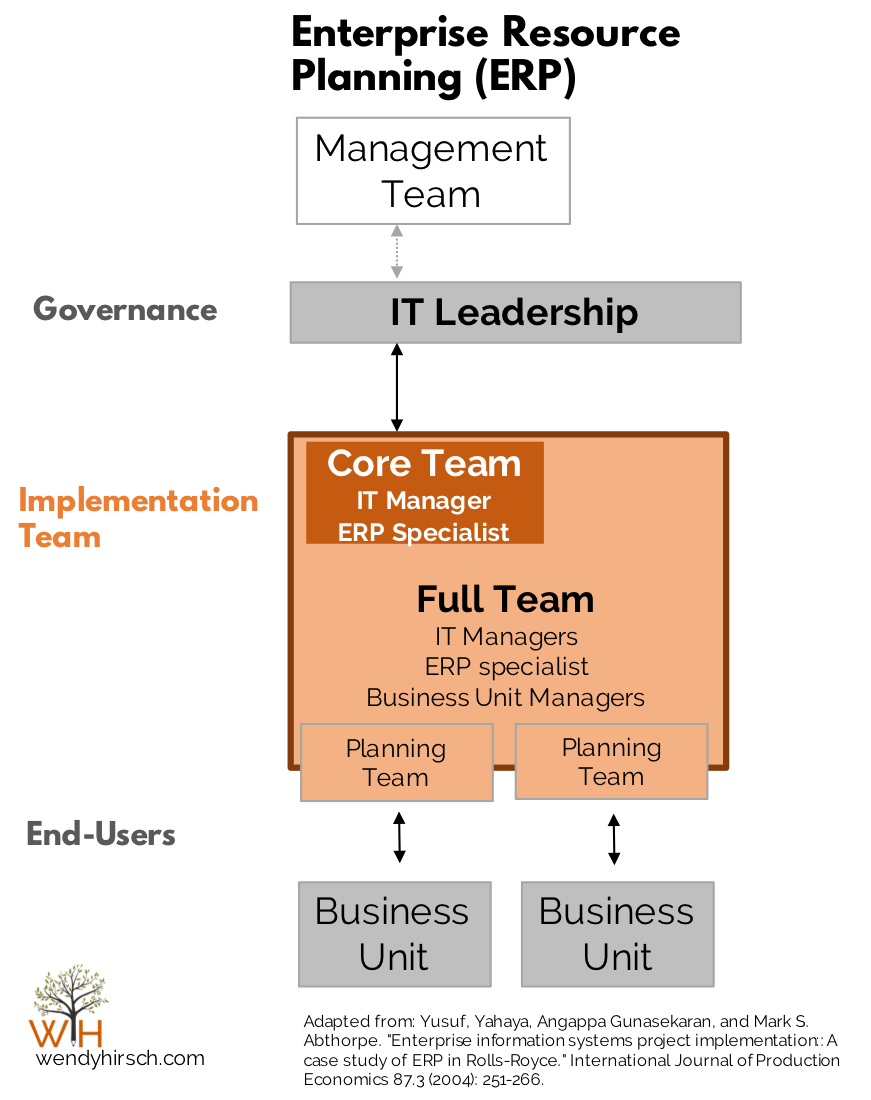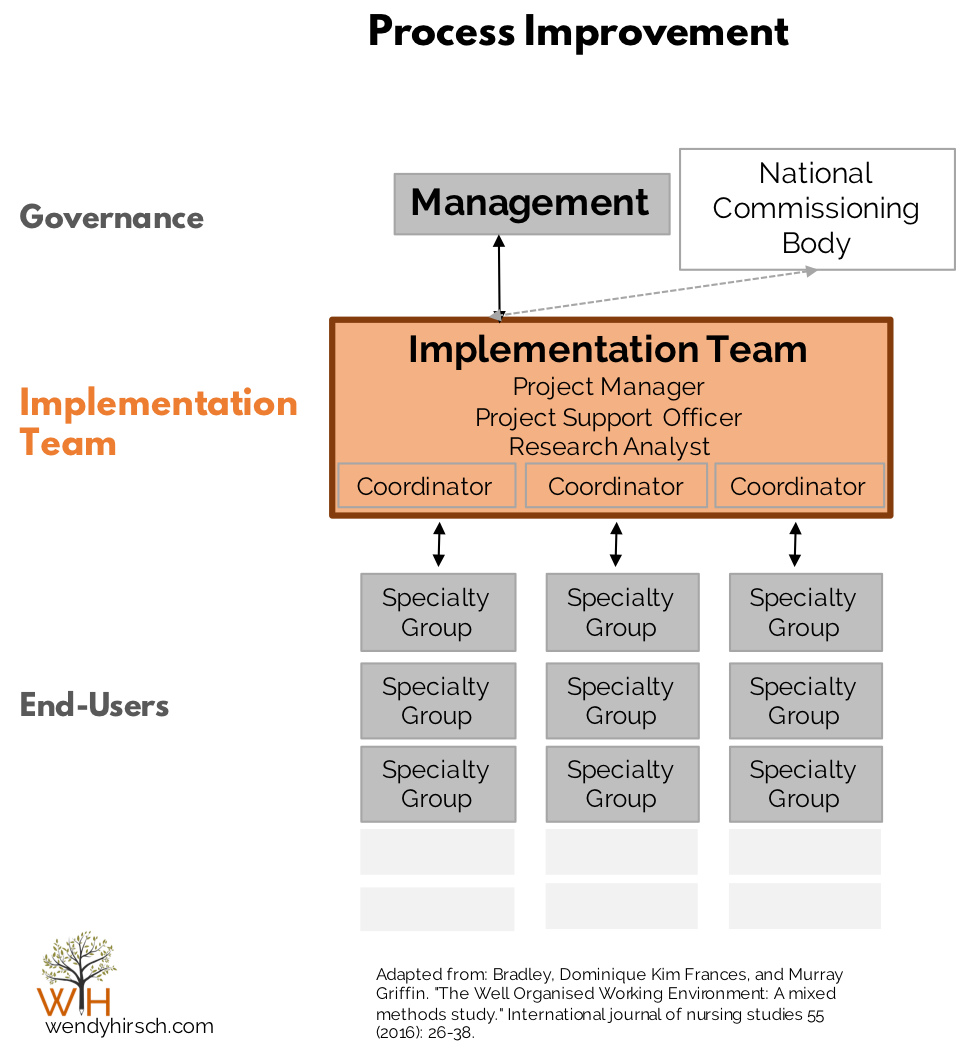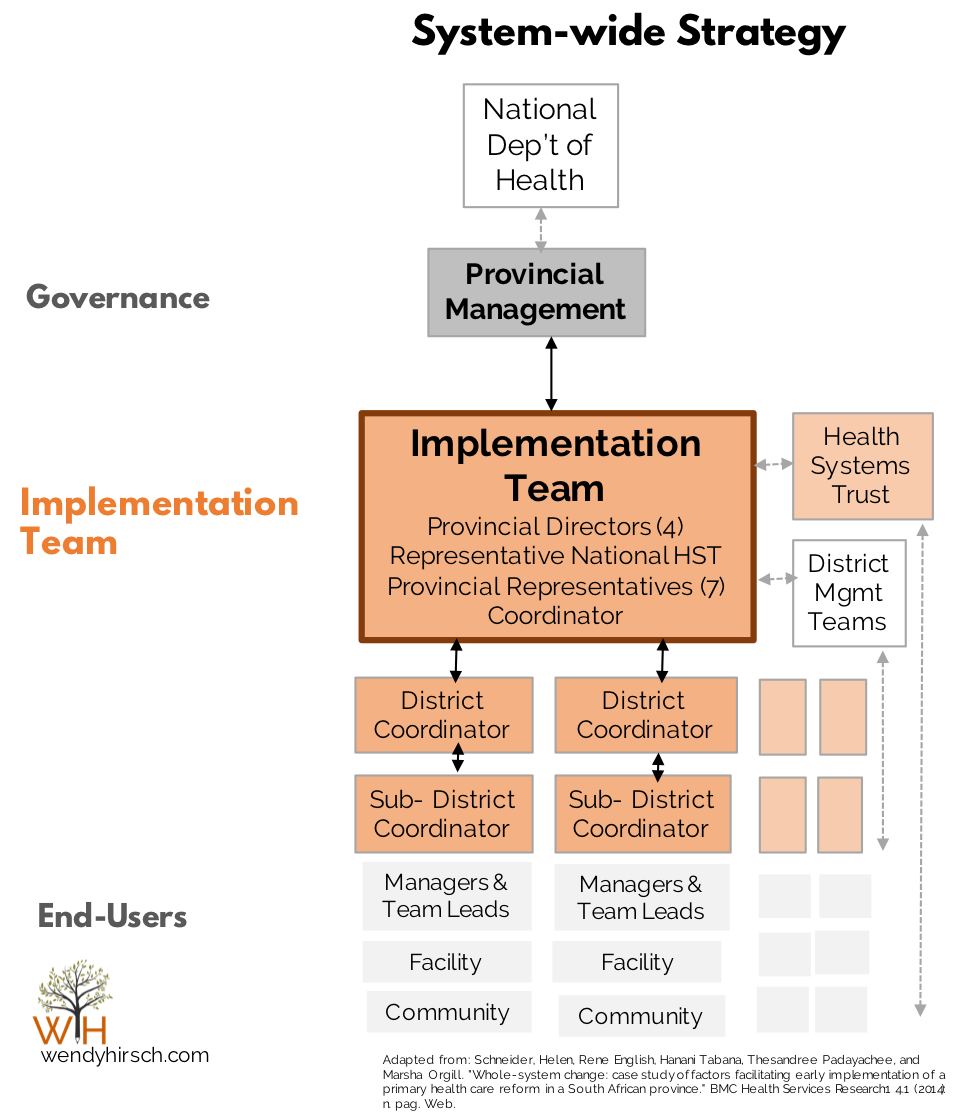In Part One of this series on change implementation teams, I reviewed factors related to the team's mandate, as well as the skills and perspectives that should be considered when staffing the team. In Part Two, I offer some ideas about how to structure your implementation team.
Structuring Considerations
There is no single structure that works well for all change implementations. However, there are general considerations that I have found to be consistently useful, including:
Ensure the structure clarifies accountabilities and distinguishes between governance, adopters/end-users, and other stakeholders.
Segment the implementation team, if necessary, to ensure it remains both inclusive and manageable.
Create liaisons to interact with specific adopter/end-user groups or other stakeholders.
A general implementation team structure that reflects these considerations is provided in Figure 1.
Figure 1.
Clarify accountabilities and linkages with the larger context
The structure of the team should reflect its mandate. Relatedly, the boundaries and linkages between the implementation team, the governance structure and stakeholders should be clear. This can help to specify the accountability and responsibilities of the implementation team, (versus others), and can ensure team members don’t lose sight of the context in which they are working.
Consider segmenting the change team: Core Team and Advisory Groups
Particularly on larger or longer-term efforts, it can be useful to create sub-teams or auxiliary teams. For instance, a core team of 2-3 individuals within the implementation team can streamline management tasks and interaction with the governance team.
If you find that a desire for inclusivity risks making the implementation too large to be effective, consider creating an advisory group. This group, which provides input to the implementation team, should have a clear remit and anticipated time commitment. Generally speaking, you’d ask this body to review and respond to specific questions about drafts or prototype proposals at defined points in the planning or execution phases of the effort.
Great candidates for an advisory group are those with specific perspectives, interests or areas of expertise that would be valuable to the effort. Advisory group members are usually more informed and involved in the implementation than general stakeholders. As a result, the implementation team should weigh input from the advisory group more heavily than that received from other forms of engagement (e.g., surveys, focus groups, town hall meetings).
At the same time, membership in the advisory group is less of a time commitment than full implementation team membership. As a result, creating an advisory group can help you to avoid having implementation team members in “name only”, which inhibits its effectiveness. If you’d love someone on the implementation team, but they aren’t able to commit the time, or you only need their input on specific aspects of the effort, consider asking them to play a role on the advisory team.
Establish liaisons or key contacts
Third, consider establishing specific liaisons or key contacts with end-user groups. These liaisons may sit on the implementation team, within the end-user groups, or both. Such liaisons can be useful to identify and adjust the innovation to meet the unique needs, challenges and opportunities of each end-user group (e.g., specific teams within a larger business unit) while also ensuring the integrity of the innovation. Suck key contacts can also put a personal face on the implementation and provide reassurance to adopters and end-users. Knowing there is a person to go to with questions or concerns, rather than addressing them to a large group or anonymous email address can make a difference.
Change Implementation Teams in Action: Three Examples
Let’s look at how the generic structure discussed in the previous section comes to life in various real-world situations. Specifically, we’ll look at teams involved in an ERP implementation, a process improvement effort, and a system-wide strategy implementation.
ERP Implementation at a car manufacturer
To oversee the implementation of an Enterprise Resource Planning (ERP) system, a luxury car manufacturer created an implementation team driven by its IT department, but also encompassing other business units. The IT department reported to the broader management team of the organization.
The implementation team included a “core team” of managers from the contractor that oversaw the IT department for the company, as well as technical specialists from the ERP vendor. Additionally, managers from the company with internal knowledge of processes, systems, and culture were on the team. Finally, the implementation team included “planning teams” from each operational unit, who managed training and process changes within their unit. (Facts sourced from Yusuf, 2004).
Process improvement at a healthcare organization
A community healthcare organization in Britain created an implementation team to oversee a business process improvement program, which they executed as part of their contract with the National Health Service (NHS). Goals and targets for the effort were provided by the NHS; however, the method of implementation was left largely to the organization. The implementation team involved in the effort consisted of a Project Manager, Project Support Officer, and Research Analyst. Additionally, three nurse coordinators, two from the organization and one hired as a contractor, interfaced with each of 38 specialty groups involved as "end-users" in the implementation. The coordinators mainly interfaced with managers of these end-user teams, but sometimes worked directly with staff using the innovation (Facts sourced from Bradley, 2016).
System-wide strategy implementation
South Africa recently put in place a national strategy to revamp how community healthcare workers support primary health throughout the country. The strategy included broad changes, including “new goals, forms of engagement with households, service delivery roles and relationships between players in the primary healthcare system” (Schneider, 2014). This example reflects the implementation team in one province.
The implementation team oversaw implementation plans, communication, progress monitoring and troubleshooting. The implementation team included Directors from each district in the province, a representative from the National Health System Trust, and representatives from various district-level entities (hospitals, finance, monitoring and evaluation, HR, etc.) The group also included a full-time coordinator who worked across the province, as well as coordinators at the district and sub-district levels, who served as a link between managers and team leaders at the district level with the implementation team. Additionally, implementation was discussed at all District-level management meetings. Representatives from the National Health System Trust provided a degree of technical assistance to all levels of the effort (Facts sourced from Schneider, 2014).
As demonstrated through these examples, although the context, scale, and content of each case are quite different the key structural elements of the implementation team remain largely the same. There is differentiation between the implementation team, governance bodies and end-user communities. The membership on the implementation team is clear; it is at times segmented into sub-teams and augmented by additional advisory groups or sources of technical assistance. There are defined liaisons tasked with supporting key end-user or adopter groups.
When putting these ideas into practice with your team, aim to start with the simplest structure possible, then add on as necessary to clarify governance, provide clear support, and enable the most efficient means for engagement of team members.
The basics of good team practice still apply
Clarifying the team's mandate, as well as staffing and structuring it appropriately will put your team in a great position to begin its work. Beyond that, implementation teams benefit from good practices that support high-performing teams in general. Things like establishing clear processes and norms to support cooperation, communication, and coordination, among others. For more on successful team practices that can benefit your implementation team, I invite you to explore my posts on teamwork here and here.
References
Bradley, Dominique Kim Frances, and Murray Griffin. "The Well Organised Working Environment: A mixed methods study." International journal of nursing studies 55 (2016): 26-38.
Schneider, Helen, Rene English, Hanani Tabana, Thesandree Padayachee, and Marsha Orgill. "Whole-system change: case study of factors facilitating early implementation of a primary health care reform in a South African province." BMC Health Services Research1 4.1 (2014): n. pag. Web.
Yusuf, Yahaya, Angappa Gunasekaran, and Mark S. Abthorpe. "Enterprise information systems project implementation:: A case study of ERP in Rolls-Royce." International Journal of Production Economics 87.3 (2004): 251-266.





